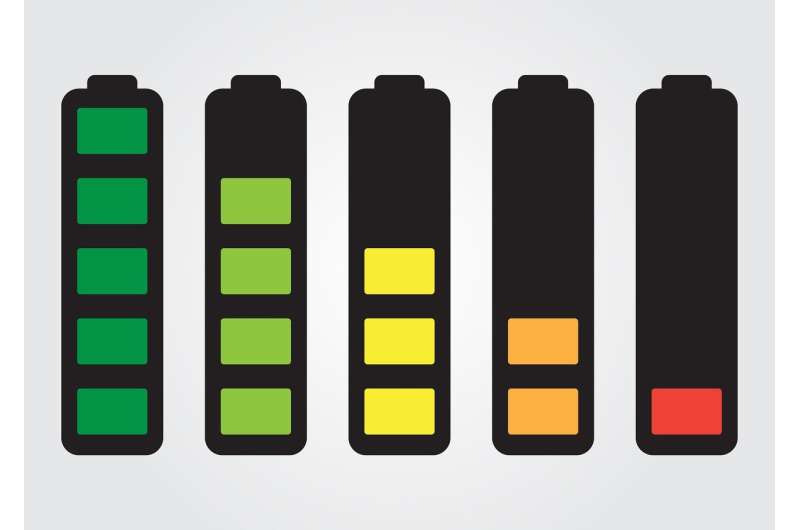As California pins much of its decarbonization hopes on energy storage, SDG&E opens a new battery facility

They don't look like much—126 cubes, each holding 16 modules of batteries—simply sitting on an expanse of flat land owned by San Diego Gas & Electric off Route 163.
But it's no exaggeration to say that California's hopes of decarbonizing its power system depend on developing a vast number of utility-scale energy storage facilities across the state, such as the one SDG&E opened earlier this month in Kearny Mesa.
"We have a goal to be net-zero of carbon emissions by 2045," said Scott Crider, SDG&E's senior vice president of customer services and external affairs, "and technologies like battery storage are going to be a central component of reaching that goal."
Battery storage facilities emit no greenhouse gasses and can act like a shock-absorber for the electric grid, providing flexibility and reducing strain when the system needs additional megawatts.
Solar production in California is so abundant during the day that the California Independent System Operator, the nonprofit that manages the grid for about 80 percent of the state, often has to send the excess to adjacent states or curtail it altogether. But when the sun goes down, solar production disappears.
Similarly, wind generation adds megawatts of clean power to the grid but on a still day or night, wind production plummets.
Natural gas power plants can fill in the gaps but natural gas is a fossil fuel. With California policymakers setting targets to derive 60 percent of its electricity from renewable sources by 2030 and 100 percent from carbon-free sources by 2045, energy storage solutions need to ramp up.
And batteries figure to play a crucial role in boosting energy storage, especially during the summer months when utility customers crank up the air conditioning and stress the electric grid.
The California system operator, known as the CAISO for short, expects to have more than 2,000 megawatts of energy storage at the ready this summer, about 10 times more than the grid operator had last year. For perspective, on a hot summer day California's system load can peak to about 40,000 megawatts.
In recent year's the California Public Utilities Commission has ordered the state's three big investor-owned utilities—SDG&E, Pacific Gas & Electric and Southern California Edison—to procure battery storage capacity.
The Kearny Energy Storage facility was one such project, delivering 20 megawatts and 80-megawatt-hours of energy via batteries housed in 126 cubes. Charged each day using electricity from the grid, the batteries can be dispatched for up to four hours when the system needs them—usually at night.
"What we want to do is reduce the amount of natural gas generation that we're using in the evening time," Crider said, "and this helps that."
Working out the math, SDG&E officials at Tuesday's opening ceremonies compared the site to a Tesla. Based on a 50 kilowatt-hour battery pack in a Model 3, they estimated the entire Kearny Energy Storage facility is the equivalent of 1,600 Teslas.
"Each one of these cubes could feed a neighborhood for a couple hours," said SDG&E project engineer Jay Bick.
Utility-scale battery systems typically use lithium-ion, the technology also seen in electric vehicles, but the Kearny Energy Storage facility uses lithium-iron phosphate batteries because they are more economic and durable. "They take longer to heat up so there is less likelihood that they would catch fire or have some kind of thermal runaway event," said Kelly Fitzgerald, SDG&E project manager.
Fires from lithium-ion batteries led to a recall on the Chevy Bolt and there have been reports of fires breaking out on Teslas. On the utility-scale front, an explosion in 2019 at an energy storage facility in Surprise, Arizona, injured nine first responders.
Skeptics of battery storage also point to its relatively high cost compared to conventional sources of power. In the early 1990s, for example, lithium-ion battery projects cost about $10,000 per kilowatt-hour.
Prices have dropped over the years. An analysis last year by the National Renewable Energy Laboratory projected storage costs for four-hour systems ranging from $143 per kilowatt-hour to $248 by 2030. The industry's breakthrough price is generally considered to be about $100 per kilowatt-hour.
SDG&E's Crider would not say how much the Kearny storage project cost, citing Public Utilities Commission rules that keep project costs confidential for three years. The project's price tag will be passed on to SDG&E customers in rates.
"But the value of this facility is we own the land so that helps reduce the cost to customers," Crider said. "It's immediately adjacent to a major substation so that reduces the cost of having to build long-distance powerlines to connect it to the grid."
The Kearny Mesa facility is one of more than 15 local energy storage and microgrid projects SDG&E is developing. By the end of the year, 144 megawatts of battery storage will come online and another 161 megawatts are scheduled to be available to the grid by 2023.
2022 The San Diego Union-Tribune.
Distributed by Tribune Content Agency, LLC.
















